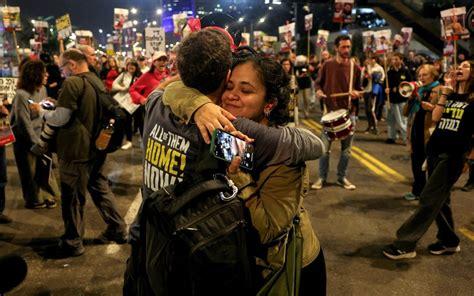
Israel and Hamas agree to ceasefire days before Trump takes power
Israel and Hamas on Wednesday agreed a ceasefire to end 15 months of war, with the first hostages set to be released on Sunday.
Donald Trump hailed the “epic deal” on Wednesday night, claiming that it could only have happened because of his election victory in November.
Hostages will be swapped for Hamas prisoners held in Israel over the course of months under the deal, which has been separated into three separate phases.
It will end with a permanent ceasefire, the full military withdrawal of Israeli forces from Gaza and the release of hostages and remains from Hamas tunnels.
Joe Biden, the US president, also took credit for the deal from White House on Wednesday night, saying “my diplomacy” forced the agreement.
Civilians celebrated on the streets of Tel Aviv and Gaza alike after the deal was announced, despite reports of additional 11th-hour demands by Hamas.
The Israeli cabinet was set to vote the deal through on Thursday.
The first phase of the deal will last six weeks and will see 33 hostages, including women and children, released. The Israeli military will leave populated areas during that time.
The second phase will see remaining male hostages released and the withdrawal of remaining Israeli forces.
The third phase will see the bodies of murdered hostages returned to their families, and the reconstruction of Gaza.
Mr Biden said the road to the deal “has not been easy” and that the negotiations had been complicated by attacks on Israel from Iran and Hezbollah.
Israel-Hamas ceasefire deal
Phase 1
A complete ceasefire
Withdrawal of Israeli forces from populated areas in Gaza
Release of a number of hostages including women, children under 19, elderly over 50 and injured or sick civilians
Palestinian civilians can return to their neighbourhood
A surge in humanitarian aid
Phase 2
A permanent end to the war
Exchange for the release of the remaining living hostages
Israeli forces withdraw from Gaza
Temporary ceasefire becomes permanent
Phase 3
Major reconstruction plan for Gaza
Final remains of hostages are returned to their families
“This is one of the toughest negotiations I have ever experienced,” he said.
The American negotiating team was formed of US government officials and Mr Trump’s team, who worked together to secure an agreement in line with ceasefire plans outlined by Mr Biden in May.
Mr Trump claimed credit for the agreement, arguing that his election victory in November had “[sic] signalled to the entire world that my Administration would seek Peace and negotiate deals to ensure the safety of all Americans, and our Allies”.
‘Hell to pay’
The president-elect, who will take office on Monday, sent his Middle East envoy to Doha earlier this week to secure the ceasefire before his inauguration on Jan 20.
He warned that Hamas would have “hell to pay” if it did not release the hostages.
Any agreement still needs to be approved by the Israeli cabinet, but the first stage of the truce is expected to come into effect with the backing of Benjamin Netanyahu, the Israeli prime minister.
Asked whether he or Mr Trump should take credit for the deal, Mr Biden replied: “Is that a joke?”
Sir Keir Starmer, the Prime Minister, said the world’s attention must now switch to securing a “permanently better future for the Israeli and Palestinian people – grounded in a two-state solution”.
But Ehud Olmert, the former Israel prime minister, said he had “doubt and fear” that the deal would bring an end to the war because not all Israeli hostages would be freed under its terms.
“There is not really an agreement about a permanent ceasefire,” he told Sky News. “There is an agreement for a temporary ceasefire, for I think about 42 days, maybe six weeks, and the return of only 33 hostages.
“There are still more hostages [not released] and we do not know how many will be alive when this [first] phase will end.”
Families of British citizens murdered by Hamas warned that there would “never be any closure” until all hostages are returned.
Ayelet Svatitzky, who lost her brothers Roi and Nadav Popplewell, said: “We’ll be worried and we’re not able to move on until the last hostage is home.”
Stephen Brisley, whose sister Lianne Sharabi was killed with her daughters Noiya and Yahel, warned that the deal had “many moving parts that could very easily fall apart”.
“Because there have been so many false dawns, there’s still that part of me that isn’t really allowing myself to believe it still, despite the fact that it’s been formally announced,” he said.
The ceasefire deal raises questions about the governance of Gaza, where both Israel and the US say Hamas cannot continue to rule.
‘Cannot coexist’
Marco Rubio, the incoming Secretary of State, said in response to the announcement that Israel “cannot coexist with armed elements who seek [its] destruction and evisceration as a state”.
Negotiations over the second phase of the ceasefire are expected to begin almost immediately after the first phase comes into force.
Israeli troops that withdraw from Gaza will be stationed on the border between the territories, ready to receive hostages released by Hamas.
The Israeli government said that Hamas introduced eleventh-hour demands for the IDF to withdraw from the Philadelphi Corridor, a strip of land between Gaza and Egypt.
Mr Netanyahu’s office said Hamas had “folded” due to his “strong insistence” that the troops remain in the short term.
Source » telegraph.co.uk





